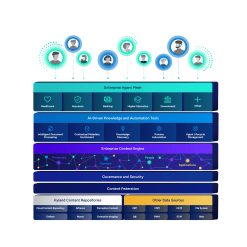Montana Department of Labor
State agency reduces communications work time from hours to minutes with Content Composer.

Harness the power of a unified content, process and application intelligence platform to unlock the value of enterprise content.
Learn more
Explore Hyland’s solutions by industry, department or the service you need.
Overview of solutionsIt's your unique digital evolution … but you don't have to face it alone. We understand the landscape of your industry and the unique needs of the people you serve.
 Overview of industries
Overview of industries
Countless teams and departments have transformed the way they work in accounting, HR, legal and more with Hyland solutions.
 Overview of departments
Overview of departments
We are committed to helping you maximize your technology investment so you can best serve your customers.
 Overview of services
Overview of services

Discover why Hyland is trusted by thousands of organizations worldwide.
Hear from our customers
Our exclusive partner programs combine our strengths with yours to create better experiences through content services.
Overview of partners
Find resources to power your organization's digital transformation.
Browse the resource center
Hyland connects your content and systems so you can forge stronger connections with the people who matter most.
Learn about HylandWith our modern, open and cloud-native platforms, you can build strong connections and keep evolving.
 Dig deeper
Dig deeper
Reading time minutes
State agency reduces communications work time from hours to minutes with Content Composer.

With more than 1 million people residing in Montana, the state’s Department of Labor and Industry works to ensure residents receive needed services.
To provide services like workforce development and unemployment insurance, effective processes must be in place so the department can assist residents effectively.
However, outdated technology slows down processes and kills efficiency. Within the department’s unemployment insurance division, creating and processing notices for residents was cumbersome. It relied on an antiquated mail merge process that was originally built in Visual Basic. “Support was really difficult. We were at a point where I was mostly concerned about a catastrophic failure, which is essentially the product might just stop working. We were at a real tipping point and needed to get the product replaced,” said Casey Greenwood, IT supervisor for the state’s Department of Labor and Industry.
That’s when the department discovered Content Composer, Hyland’s flagship customer communications management (CCM) product.
The state of Montana had already implemented Hyland’s content and process management suite, Perceptive Content, statewide, so turning to the vendor for a complementary offering that seamlessly integrated with it was an easy decision.
Content Composer simplified the creation of unemployment insurance notices sent to individuals and employers throughout the state. Previously, the staff used a Microsoft Word mail merge to manually tailor each communication for its recipients. But Word’s functionality was limited, reducing staff to either make changes to the entire document or none at all. With Content Composer, the process is more controlled. Now, the department provides staff with access to only the essential portions of documents where changes will need to be made. All other aspects — such as font size, address and location — are locked down to ensure consistency.
— Casey Greenwood, IT supervisor for the state’s Department of Labor and Industry
This document creation control has ensured consistency in tone and language across all content distributed by the department’s unemployment insurance division. The department now has set standards for all communications, and Content Composer helps to ensure each communication meets these goals. Ultimately, it helps to improve the customer experience (CX) for residents receiving these communications.
Within the unemployment insurance division, hundreds to thousands of documents are distributed to residents daily, including payments and related items. As a result, in addition to the user-driven mail merge that takes place, an automated mail merge also processes notices every night. Content Composer has sped up this batch process exponentially.
“Our previous automated merge process literally took hours to perform every night. It was extremely slow,” Greenwood said. “With Content Composer, these notices — and we’re talking anywhere from 2,000 to 3,000 at a time — get finished in a matter of minutes. It’s that fast. We went from waiting hours to get it done to waiting 10 to 15 minutes, tops.”
With the previous practice, an on-call programmer was needed to monitor the automated mail merge and related processes all night. Now, the entire process takes about 45 minutes.
—Casey Greenwood, IT supervisor for the state’s Department of Labor and Industry
In addition to the consistency and control it brings to document creation, Content Composer provides many other benefits to the Department of Labor and Industry. The product’s integration with Perceptive Content is one of those benefits. Perceptive Content ingests all documents managed within Content Composer. From there, the documents are distributed via the system’s workflow for processing and distribution. The vast majority of documents are mailed out each morning after nightly processing. One of the benefits of working with the same vendor for both its content process management and CCM needs is the consistency in the solution design. For example, the department can consistently name documents between both systems, which helps facilitate automated indexing of documents — further speeding up processes.
Before Content Composer, templates were saved as Word documents. As a result, if a change needed to be made to the header of a template, all documents corresponding with that template — which could be in the thousands — needed to be changed individually.
Now, all document components, like the header, footer and body copy, are separated so the information can be shared between documents. When a change is made to one element, it can change that element for all documents.
Improves user satisfaction
“It’s much easier to use Content Composer,” Greenwood said. “Our old process was fairly complicated, and users would face problems along the way. We used to have merge failures daily. Now, everything is much more straightforward and merge failures have become nearly non-existent.”
Grows to scale with the organization
Based on its initial success with the product, the Department of Labor and Industry plans to convert notices stored in Oracle Reports to Content Composer. That means the department will more than double the amount of documents created each night — from 1,000 to 2,000 documents up to 3,000 to 4,000 documents in the winter months.